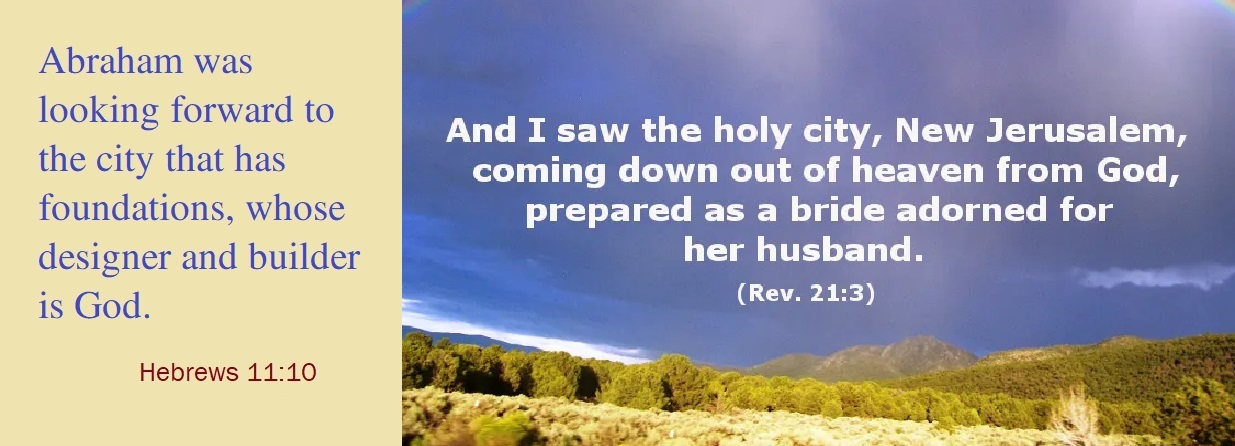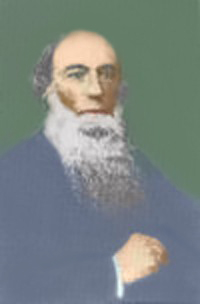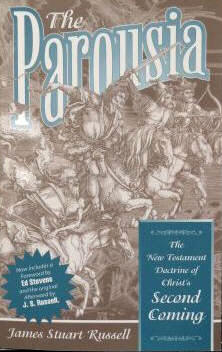
Biblical Evidence for the 1st Century Return of Christ
… parousiafulfilled.com
In this article, we will examine the Seventh Vision of the Book of Revelation, based on the particular commentary of James Stuart Russell 1 in Part III of his book, “The Parousia”. 2
“And I saw a new heaven and a new earth: for the first heaven and the first earth were passed away; and there was no more sea. And I John saw the holy city, new Jerusalem, coming down from God out of heaven, prepared as a bride adorned for her husband.” (Revelation 21:1,2 KJV)
Russell asks:
“ Where we are. Is this earth, or is it heaven? Every familiar landmark has disappeared; the old has vanished, and given place to the new: it is a new heaven above us; it is a new earth beneath us. New conditions of life must exist, for ‘there is no more sea.’ Plainly we have here a representation in which symbolism is carried to its utmost limits; and he who would deal with such gorgeous imagery as with prosaic literalities is incapable of comprehending them. But the symbols, though transcendental, are not unmeaning. ‘They serve unto the example and shadow of heavenly things;’ and all the pomp and splendour of earth are employed to set forth the beauty of moral and spiritual excellence.”
Russell concludes that this vision is not of an earthly scene:
“ It is impossible to regard this picture as the representation of any social condition to be realised upon earth. There are, indeed, certain phrases which at first seem to imply that earth is the scene where these glories are manifested: the holy city is said to ‘come down out of heaven;’ the tabernacle of God is said to be ‘with men;’ ‘the kings of the earth’ are said to ‘bring their glory and honour into it; ‘ but, on the other hand, the whole conception and description of the vision forbid the supposition of its being a terrestrial scene. In the first place, it belongs to ‘the things which must shortly come to pass;’ it falls strictly within apocalyptic limits. ”
Twice in the Apocalypse, Jesus declared that all the events therein : “… must soon take place.” (Rev 1:1; 22:6)
Thus Russell correctly observes that:
“ It is, therefore, no vision of the future; it belongs as much to the period called ‘the end of the age’ as the destruction of Jerusalem does; and we are to conceive of this renovation of all things,---this new heaven and new earth, as contemporaneous with, or in immediate succession to, the judgment of the great harlot, to which it is the counterpart or antithesis.”
“ Secondly, What is the chief figure in this visionary representation? It is the holy city, new Jerusalem. But the new Jerusalem is always represented in the Scriptures as situated in heaven, not on earth. St. Paul speaks of the Jerusalem which is above, in contrast with the Jerusalem below. How can the Jerusalem which is above belong to earth? There cannot be a reasonable doubt that the city which is here depicted in such glowing colours is identical with that which is referred to in Heb. xii. 22, 23: ‘Ye are come unto mount Sion, and unto the city of the living God, the heavenly Jerusalem, and to an innumerable company of angels; to the general assembly and church of the first-born, which are written in heaven, and to God the Judge of all, and to the spirits of just men made perfect.’ Clearly, therefore, the holy city is the abode of the glorified; the inheritance of the saints in light; the mansions of the Father’s house, prepared for the home of the blessed.”
“ Once more, this conclusion is certified by the representation of its being the dwelling-place of the Most High Himself: ‘The Lord God Almighty and the Lamb are the temple of it;’ ‘the throne of God and of the Lamb shall be in it;’ ‘his servants shall serve him, and they shall see his face.’”
“ We therefore conclude that the vision sets forth the blessedness and glory of the heavenly state, into which the way was fully opened at the ‘end of the age,’ or συντέλεια τοῦ αἰῶνος , according to the showing of the Epistle to the Hebrews. ”
Russell then notes the description of the holy city in Rev. 21:9-27; 22: 1-5:
“ There is an apparent confusion of the figures by which the new Jerusalem is represented, being sometimes personified as the bride, the Lamb's wife, and sometimes described as a city. The same double figure is employed in the description of the harlot, or old Jerusalem, which is sometimes represented as a woman and sometimes as a city. In the seventh vision the figure of the bride is dropped almost as soon as it is introduced., and the whole of the remaining description is occupied with the details of the architecture, the wealth, and splendour, and glory of the city. Some of the features are evidently derived from the visionary city beheld by Ezekiel; but there is this remarkable difference, that whereas the temple and its elaborate details occupy the principal part of the Old Testament vision, no temple at all is seen in the apocalyptic vision,---perhaps for the reason that where all is most holy no one place has greater sanctity than another, or because where God’s presence is fully manifested, the whole place becomes one great temple. …”
“ In Hebrews xi.10 we meet with the remarkable statement that the patriarch Abraham sojourned as a stranger in the very land which had been promised to him as his own possession, and that he did so because he had faith in a larger and higher fulfillment of the promise than ANY MERE EARTHLY AND HUMAN CITY could have bestowed. ‘He looked for the city which hath the foundations, whose builder and maker is God.’ What is this but the very city described in the Apocalypse---the city which has twelve foundations, inscribed with the names of the twelve apostles of the Lamb; the city which is built by no mortal hands; ‘the city of the living God,’ the heavenly Jerusalem? This is a decisive proof, first, that the writer of the epistle had read the Apocalypse, and, secondly, that he recognised the vision of the new Jerusalem as a representation of the heavenly world.”
“ 'And he saith unto me, Seal not the sayings of the prophecy of this book: for the time is at hand. He that is unjust, let him be unjust still: and he which is filthy, let him be filthy still: and he that is righteous, let him be righteous still: and he that is holy, let him be holy still. And, behold, I come quickly;' ” (Revelation 22:10‐12a KJV)
“ ‘He which testifieth these things saith, Surely I come quickly!” (Revelation 22:20)
Russell draws our attention to the imminence of the events prophesied here:
“ Seven times over it is declared, in one form or another, that all is on the point of being accomplished. The statement with which the book opens is repeated at this close, that the angel of the Lord has been commissioned ‘to shew unto his servants things which must shortly come to pass.’ The monitory announcement, ‘Behold, I come quickly,’ is thrice made into this concluding section.” The Seer is commanded not to seal the book of the prophecy, because ‘the time is at hand.’ So imminent is the end that it is intimated that now it is too late for any alteration in the state or character of men; such as they are so must they continue: ‘He that is unjust, let him be unjust still.’
“ The invocation addressed by the four living creatures to the expected Son of man, ‘Come!’ (chap. vi. 1, 3, 5, 7), is repeated by the Spirit and the bride; while all that hear are invited to join in the cry: and, lastly, the final expression of the whole book is the fervent utterance of the prayer, ‘Amen! Come, Lord Jesus.’ All these are indications, which cannot be misunderstood, that the predictions contained in the Apocalypse were not to be slowly evolved as ages roll on, but were on the eve of almost instant accomplishment. The whole prophecy, from the first to last, relates to the immediate future, with the solitary exception of the six verses of chap. xx. 5-10 3 . Nineteen-twentieths of the Apocalypse, we might almost say ninety-nine hundredths, belong, according to its own showing, to the very days then present, the closing days of the Jewish age. The coming of the Lord is its grand theme: with this it opens, with this it closes, and from beginning to end this event is contemplated as just about to take place. … ”
As Russell explains, the key to the Book of Revelation:
“ is the declaration so frequently made that all is on the point of fulfillment. … the original readers were competent … to understand the Apocalypse without an interpreter, … because they recognised its connection with the events of their own day.”
“ From first to last the book itself bears decisive testimony to the immediate fulfillment of its predictions. It opens with the express declaration that the events to which it refers ‘must shortly come to pass,’ and it closes with the reiteration of the same statement,---‘The Lord God hath sent his angel to shew unto his servants the things which must shortly come to pass.’ ‘The time is at hand.’”
Russell asserts that the Apocalypse is a:
“ prediction of events which were to take place in connection with the Parousia, the coming in His kingdom of the Son of man, an event which He declared would happen before the passing away of the existing generation, and which some of the disciples would live to witness. … how could it be otherwise than that St. John and his fellow-disciples should believe themselves on the point of witnessing the fulfillment of their cherished hopes? … in the days of St. John the Parousia was universally believed by the whole Christian church to be close at hand. … It marked a new epoch in the divine administration. … Until the ‘harlot city’ [ed. earthly Jerusalem] was judged and condemned, the ‘holy city’ [ed. heavenly Jerusalem] was not prepared as the habitation of the saints.”
Friends, note the significance of these things for us today …
“ the covenant-nation [ed. earthly Israel] no longer exists; there are no longer Jews and Gentiles, circumcised and uncircumcised; the Israel of God is wider and greater than Israel after the flesh; Jerusalem which is above is not the mother of Jews, but is ‘the mother of us all.’ ” [ed. See Galatians 3:28; 4:26]
Read more on the prophesied “imminence” of the parousia (“Second Coming”) of Christ in these articles:
NB: “Unless Otherwise indicated, all Scriptures are from the Holy Bible, English Standard Version, copyright © 2001, 2007, 2011, 2016 by Crossway Bibles, a division of Good News Publishers. Used by permission. All rights reserved.”

1… James Stuart Russell (1816-1895) was a minister in the Congregational Church at Great Yarmouth, Tottenham, Edmonton, and Bayswater. He held to a past fulfillment of the Second Advent and in 1878 he published a book on this subject, entitled “The Parousia: The New Testament Doctrine of Our Lord’s Second Coming”.
Photo of J S Russell: author of “The Parousia”. Photograph, colorized by Virgil Vaduva
2… “The Parousia” by J. Stuart Russell, pp 525-537.
3… Russell here refers to the passage in Revelation 20:5-10 concerning a period of a “thousand years” and the “first resurrection“ etc. This topic is covered in a separate essay [ed: to be included at a future date].

The Parousia: The New Testament Doctrine of Our Lord’s Second Coming by Russell, James Stuart, International Preterist Association, Bradford PA, 2003. (Originally published by T. Fisher Unwin, London, 1887).
Photo of cover: “The Parousia” by J S Russell (IPA, 2003).
copyright © 2019‐2023 Kenneth Higgs ‐ ParousiaFulfilled.com ‐ v2.01